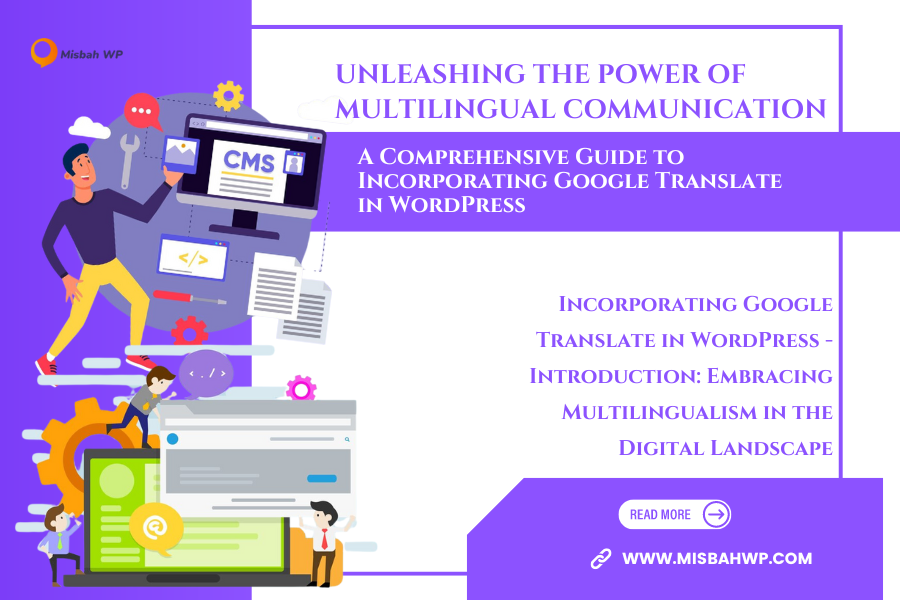
Unleashing the Power of Multilingual Communication: A Comprehensive Guide to Incorporating Google Translate in WordPress
Incorporating Google Translate in WordPress - Introduction: Embracing Multilingualism in the Digital Landscape
In today's interconnected digital landscape, the reach of a website extends far beyond geographical boundaries. The internet has transcended borders, enabling individuals from diverse cultures and backgrounds to access and engage with content from around the world. Yet, despite this interconnectedness, language remains a formidable barrier. While English serves as a lingua franca for a significant portion of online communication, the richness and diversity of the global audience cannot be encapsulated by a single language.
Enter Google Translate, a revolutionary tool that has reshaped the way we navigate linguistic differences. By seamlessly integrating Google Translate into your WordPress themes, you embark on a journey to conquer these language barriers and connect with a global audience on a profound level. This comprehensive guide is your compass, navigating you through the intricate process of merging Google Translates capabilities with the versatile WordPress platform. The ultimate goal? To create an online space that resonates harmoniously with readers, irrespective of their native tongues.
Harnessing Google Translates Potential: A Universal Language Bridge
Imagine the power of instantaneously translating your website's content into over 100 languages, enabling people from different corners of the world to engage with your ideas, products, and stories. Google Translate isn't just a translation tool; it's a bridge between languages, cultures, and perspectives. Its integration with WordPress ushers in a new era of online accessibility, transforming your website into a global hub of communication and exchange.
The Case for Google Translate
Google Translate is a heavyweight in the realm of translation services, facilitating real-time translation between over 100 languages. By integrating this potent tool into your WordPress website, you're not only breaking linguistic barriers but also embracing a broader audience and potentially expanding into international markets. With a user-friendly interface and instant translation capabilities, Google Translate enhances user experience and engagement, fostering a truly inclusive online environment.
Step-by-Step Integration Guide
Step 1: Choose Your Integration Method
You have multiple avenues to infuse Google Translates magic into your WordPress website. Two primary methods are plugin integration and manual widget addition.
Plugin Method:
Access your WordPress dashboard.
Navigate to "Plugins" and select "Add New."
Search and locate your chosen plugin (e.g., "Google Language Translator").
Install and activate the plugin.
Configure the plugin settings, specifying the languages you wish to offer for translation.
Manual Method:
Visit the Google Translate website (translate.google.com/manager/website/).
Click "Add to your website now."
Provide your website details and customize settings.
Copy the code snippet generated.
Log in to your WordPress dashboard.
Edit template files (header or footer.php) or utilize a custom widget area to embed the code snippet strategically.
Step 2: Testing and Customization
After successful integration, comprehensive testing is paramount to ensure translated content's accuracy and coherency. While Google Translate is remarkable, automated translations may occasionally falter, making user feedback a valuable resource for improvements.
Certain plugins extend customization features, enabling you to control the widget's appearance and behaviour. This empowers you to harmonize the translation widget's look, positioning, and language selection with your website's aesthetics and user preferences.
Step 3: Vigilant Performance Monitoring
Continual vigilance over the integrated translation solution's performance is key. Utilize Google Analytics to glean insights into user engagement and behaviour post-translation. If issues arise or user feedback indicates discrepancies, be prepared to swiftly make necessary adjustments.
Step 4: Balancing Automation with Human Translation
While automated translation tools shine in convenience, precision and cultural nuance are occasionally non-negotiable. For critical content such as legal documents, product descriptions, or marketing material, consider investing in professional human translation. This judicious fusion of automation and human touch heightens your website's credibility and impact.
Conclusion
In a digital landscape defined by diversity and global connectivity, conquering language barriers is an essential stride towards audience expansion. Google Translate offers an accessible and dynamic solution for WordPress users committed to catering to a varied readership. By diligently selecting the integration method, conducting thorough testing, personalizing the translation widget, and diligently monitoring performance, you're paving the way for a seamless multilingual experience that fosters user satisfaction and propels your digital presence. While automated prowess is remarkable, weaving in human translation for pivotal moments solidifies your website's authenticity and resonance across cultures and languages.

